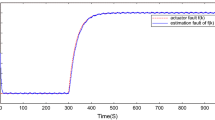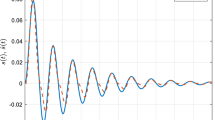Abstract
This paper considers the problem of robust \(H_{\infty }\) fault detection for a class of Itô stochastic Takagi–Sugeno fuzzy systems with time-varying delays and parameter uncertainties. The purpose is to design fuzzy-rule-independent and fuzzy-rule-dependent fault detection filters, which guarantee the fault detection system is not only mean square asymptotically stable, but also satisfies a prescribed \(H_{\infty }\)-norm level for all admissible uncertainties. Via the application of Lyapunov stability theory and the linear matrix inequality technique, novel delay-dependent solvability conditions are obtained. Weighting fault signal approach is utilized to improve the performance of the fault detection system, and explicit expression of the desired filter parameters is characterized by congruence transformation, matrix decomposition, and convex optimization technique. A numerical example and a mass-spring-damper mechanical system are employed to illustrate the usefulness and effectiveness of the proposed method.








Similar content being viewed by others
References
L. Bai, Z. Tian, S. Shi, Design of \(H_{\infty }\) robust fault detection filter for linear uncertain time-delay systems. ISA Trans. 45(4), 491–502 (2006)
M. Bouattour, M. Chadli, M. Chaabane, A.E. Hajjaji, Design of robust fault detection observer for Takagi–Sugeno models using the descriptor approach. Int. J. Control Autom. Syst. 9(5), 973–979 (2011)
Y.Y. Cao, Z. Lin, Robust stability analysis and fuzzy-scheduling control for nonlinear systems subject to actuator saturation. IEEE Trans. Fuzzy Syst. 11(1), 57–67 (2003)
J. Chen, R.J. Patton, Robust model-based fault diagnosis for dynamic systems (Springer, New York, 1999)
H. Dong, Z. Wang, H. Gao, Fault detection for Markovian jump systems with sensor saturations and randomly varying nonlinearities. IEEE Trans. Circuits Syst. Regul. Pap. 59(10), 2354–2362 (2012)
H. Dong, Z. Wang, H. Gao, Distributed \(H_{\infty }\) filtering for a class of Markovian jump nonlinear time-delay systems over lossy sensor networks. IEEE Trans. Ind. Electron. 60(10), 4665–4672 (2013)
G. Feng, A survey on analysis and design of model-based fuzzy control systems. IEEE Trans. Fuzzy Syst. 14(5), 676–697 (2006)
H. Gao, T. Chen, L. Wang, Robust fault detection with missing measurements. Int. J. Control 81, 804–819 (2008)
H. Gao, Y. Zhao, J. Lam, K. Chen, \(H_{\infty }\) Fuzzy filtering of nonlinear systems with intermittent measurements. IEEE Trans. Fuzzy Syst. 17(2), 291–300 (2009)
X. Guan, C.L. Chen, Delay-dependent guaranteed cost control for T–S fuzzy systems with time delays. IEEE Trans. Fuzzy Syst. 12(2), 236–249 (2004)
X. He, Z. Wang, D. Zou, Networked fault detection with random communication delays and packet losses. Int. J. Syst. Sci. 39, 1045–1054 (2008)
H. Huang, D.W.C. Ho, Delay-dependent robust control of uncertain stochastic fuzzy systems with time-varying delay. IET Control Theory Appl. 1(4), 1075–1085 (2007)
I. Hwang, S. Kim, Y. Kim, C.E. Seah, A survey of fault detection, isolation, and reconfiguration methods. IEEE Trans. Control Syst. Technol. 18, 636–653 (2010)
B. Jiang, M. Staroswiecki, V. Cocquempot, \(H_{\infty }\) fault detection filter design for linear discrete-time systems with multiple time delays. Int. J. Syst. Sci. 34(5), 365–373 (2003)
M. Jin, R. Li, Z. Xu, X. Zhao, Reliable fault diagnosis method using ensemble fuzzy ARTMAP based on improved bayesian belief method. Neurocomputing 133(10), 309–316 (2014)
J. Lam, S. Zhou, Dynamic output feedback \(H_{\infty }\) control of discrete-time fuzzy systems: a fuzzy-basis-dependent Lyapunov function approach. Int. J. Syst. Sci. 38(1), 25–37 (2007)
C. Lin, Q. Wang, T.H. Lee, Y. He, LMI Approach to Analysis and Control of Takagi–Sugeno Fuzzy Systems With Time Delay (Lecture Notes in Control and Information Sciences) (Springer, New York, 2007)
L. Li, X. Liu, New results on delay-dependent robust stability criteria of uncertain fuzzy systems with state and input delays. Inf. Sci. 179, 1134–1148 (2009)
T. Li, Y. Zhang, Fault detection and diagnosis for stochastic systems via output PDFs. J. Franklin Inst. 348, 1140–1152 (2011)
Y. Long, G. Yang, Fault detection for networked control systems subject to quantisation and packet dropout. Int. J. Syst. Sci. 44(6), 1150–1159 (2013)
R. Lu, H. Li, Y. Zhu, Quantized \(H_{\infty }\) filtering for singular time-varying delay systems with unreliable communication channel. Circuits Syst. Signal Process. 31(2), 521–538 (2012)
X. Mao, Stochastic Differential Equations and Applications (Horwood Publication, Chichester, 1997)
Z. Mao, B. Jiang, P. Shi, Observer based fault-tolerant control for a class of nonlinear networked control systems. J. Franklin Inst. 347, 940–956 (2010)
S.K. Nguang, P. Shi, S. Ding, Fault detection for uncertain fuzzy systems: an LMI approach. IEEE Trans. Fuzzy Syst. 15(6), 1251–1262 (2007)
Y. Niu, D.W.C. Ho, C.W. Li, Filtering for discrete fuzzy stochastic systems with sensor nonlinearities. IEEE Trans. Fuzzy Syst. 18(5), 971–978 (2010)
O. Ou, Y. Mao, H. Zhang, L. Zhang, Robust \(H_{\infty }\) control of a class of switching nonlinear systems with time-varying delay via T–S fuzzy model. Circuits Syst. Signal Process. 33, 1411–1437 (2014)
T.S. Sidhu, Z. Xu, Detection of incipient faults in distribution underground cables. IEEE Trans. Power Delivery 25, 1363–1371 (2010)
K. Tanaka, T. Ikeda, H.O. Wang, Robust stabilization of a class of uncertain nonlinear systems via fuzzy control: quadratic stability, \(H_{\infty }\) control theory and linear matrix inequalities. IEEE Trans. Fuzzy Syst. 4, 1–13 (1996)
C. Tseng, Robust fuzzy filter design for a class of nonlinear stochastic systems. IEEE Trans. Fuzzy Syst. 15(2), 261–274 (2007)
X. Wan, H. Fang, Fault detection for discrete-time networked nonlinear systems with incomplete measurements. Int. J. Syst. Sci. 44, 2068–2081 (2013)
Y. Wang, S. Zhang, Z. Li, M. Zhang, Fault detection for a class of nonlinear singular systems over networks with mode-dependent time delays. Circuits Syst. Signal Process. (2014). doi:10.1007/s00034-014-9797-2
X. Wei, M. Verhaegen, Robust fault detection observer design for linear uncertain systems. Int. J. Control 84(1), 197–215 (2011)
L. Wu, D.W.C. Ho, Fuzzy filter design for nonlinear Itô stochastic systems with application to sensor fault detection. IEEE Trans. Fuzzy Syst. 17(1), 233–242 (2009)
S. Xu, T. Chen, Robust \(H_{\infty }\) control for uncertain stochastic systems with state delay. IEEE Trans. Autom. Control. 47(12), 2089–2094 (2002)
S. Xu, T. Chen, \(H_{\infty }\) output feedback control for uncertain stochastic systems with time-varying delays. Automatica 40, 2091–2098 (2004)
X. Yao, L. Wu, W. Zheng, Fault detection filter design for markovian jump singular systems with intermittent measurements. IEEE Trans. Signal Process. 59(7), 3099–3199 (2011)
W. Yang, M. Liu, P. Shi, \(H_{\infty }\) filtering for nonlinear stochastic systems with sensor saturation, quantization and random packet losses. Signal Process. 92, 1387–1396 (2012)
B. Zhang, S. Xu, G. Zong, Y. Zou, Delay-dependent stabilization for stochastic fuzzy systems with time delays. Fuzzy Sets Syst. 158, 2238–2250 (2007)
H. Zhang, Y. Wang, D. Liu, Delay-dependent guaranteed cost control for uncertain stochastic fuzzy systems with multiple time delays. IEEE Trans. Syst. Man Cybern. B Cybern. 38(1), 126–140 (2008)
L. Zhang, E.K. Boukas, L. Baron, H.R. Karimi, Fault detection for discrete-time Markov jump linear systems with partially known transition probabilities. Int. J. Control 83(8), 1564–1572 (2010)
X. Zhang, G. Lu, Y. Zheng, Stabilization of networked stochastic time-delay fuzzy systems with data dropout. IEEE Trans. Fuzzy Syst. 16, 798–807 (2008)
Y. Zhang, H. Fang, T. Jiang, Fault detection for nonlinear networked control systems with stochastic interval delay characterisation. Int. J. Syst. Sci. 43, 952–960 (2012)
X. Zhao, L. Zhang, P. Shi, H.R. Karimi, Robust control of continuous-time systems with state-dependent uncertainties and its application to electronic circuits. IEEE Trans. Ind. Electron. 61(8), 4161–4170 (2014)
Y. Zhao, J. Lam, H. Gao, Fault detection for fuzzy systems with intermittent measurements. IEEE Trans. Fuzzy Syst. 17, 398–410 (2009)
M. Zhong, H. Ye, P. Shi, G. Wang, Fault detection for Markovian jump systems. IEE Proc.-Control Theory Appl. 152, 397–402 (2005)
S. Zhou, W. Ren, J. Lam, Stabilization for T–S model based uncertain stochastic systems. Inf. Sci. 181, 779–791 (2011)
Acknowledgments
The authors would like to thank the editors and the anonymous referees for their valuable comments that greatly improved the exposition of the paper. This work was supported by the National Natural Science Foundation of China under Grant 61403178, 61403199 and by the Natural Science Foundation of Jiangsu Province under Grant BK20140770.
Author information
Authors and Affiliations
Corresponding author
Appendix
Appendix
Proof of Theorem 1
Define the following Lyapunov function candidate for the system \(({{{\tilde{\Sigma } }_c}})\) in (12) as follows:
Using Itô formula in Lemma 1, we obtain the stochastic differential as
By Lemma 2, we have
where (5) and the relationship
are used. From (21), it is easy to see
Noting (7) and (40) and using Lemmas 3 and 4, we have
and
Substituting (41) and (42) into (39) with \(v(t) = 0\) results in
where \({\eta ^\mathrm{T}}(t) = \left[ {{\xi ^\mathrm{T}}(t)\;\;{x^\mathrm{T}}({t - {\tau _1}(t)} )\;\;{x^\mathrm{T}}({t - {\tau _2}(t)})} \right] \) and
By the Schur complement formula, it follows from (21) that \(\Theta _i < 0\), which together with (43) implies
for all
Therefore, we have that the fuzzy stochastic FD system \(({{{\tilde{\Sigma } }_c}})\) in (12) with \(v(t) = 0\) is asymptotically mean square stable for all admissible uncertainties.
Now, we will establish the \(H_{\infty }\) performance for the fuzzy stochastic FD system \(({{{\tilde{\Sigma } }_c}})\) in (12). Assuming zero initial condition, we have
According to Lemma 2, we can find
It follows from (41), (42), that
where \({\psi ^\mathrm{T}}(t) = \left[ {{\xi ^\mathrm{T}}(t)\;\;{x^\mathrm{T}}({t - {\tau _2}(t)} )\;\;{v^\mathrm{T}}(t)} \right] \) and
By Schur complement, (21) implies \({\Omega _i} < 0\), and thus
which implies (18). The \(H_{\infty }\) performance has been established and the proof is completed. \(\square \)
Proof of Theorem 2
By Schur complement, the matrix inequality condition (21) in Theorem 1 can be described as the following matrix inequality:
where
Performing a congruence transformation to (45) by diagonal matrix \({\text {diag}}(I,\;I,\;I,\;I,P,\;I,\;I,\;I,\;I,\;I )\), we obtain
Let \(P \triangleq \mathrm{diag}({U,\;V}) > 0\) in (46), where \( U \in {\mathbb {R}^{2n \times 2n}}\) and \(V \in {\mathbb {R}^{k \times k}} \); we get a new result. Specially, given a scalar \(\gamma >0\), the fuzzy stochastic fault detection system \(({{{\tilde{\Sigma } }_c}})\) in (12) is asymptotically mean square stable with an \({H_\infty }\) performance level \(\gamma \) if there exist \(U>0\) and \(V>0\) such that the following LMI holds:
where
Now, partition \(U\) as
where \({U_k} \in {\mathbb {R}^{n \times n}},\;k = 1,\;2,\;3.\)
Without loss of generality, we assume \(U_2\) is nonsingular; if not, \(U_2\) may be perturbed by \(\Delta {U_2}\) with sufficiently small norm such that \(U_2+\Delta {U_2}\) is nonsingular and satisfying (47). Define the following matrices that are also nonsingular:
and
Performing a congruence transformation to (47) by diagonal matrix \(diag(\aleph ,\;I,I,I,I,\aleph ,I,I,I,I,I)\), we get
where
Considering (52), we can get LMI (24) from (51). Moreover, note that (50) is equivalent to
Also note that the filter matrices \(A_{c}, B_{c}\), and \(C_{c}\) in (10) can be written as (53), which implies that \({{U_2}^{ - T}{U_3}}\) can be viewed as a similarity transformation on the state-space realization of the filter and, as such, has no effect on the filter mapping from \(y\) to \(\chi _{c}\). Without loss of generality, we set \({{U_2}^{ - T}{U_3}}=I\) and thus obtain (26). Therefore, the filter \(({{{ \Sigma }_c}})\) in (10) can be constructed by (26). This completes the proof. \(\square \)
Rights and permissions
About this article
Cite this article
Zhuang, G., Yu, X. & Chen, J. Fault Detection Filtering for Uncertain Itô Stochastic Fuzzy Systems With Time-Varying Delays. Circuits Syst Signal Process 34, 2839–2871 (2015). https://doi.org/10.1007/s00034-015-9994-7
Received:
Revised:
Accepted:
Published:
Issue Date:
DOI: https://doi.org/10.1007/s00034-015-9994-7




